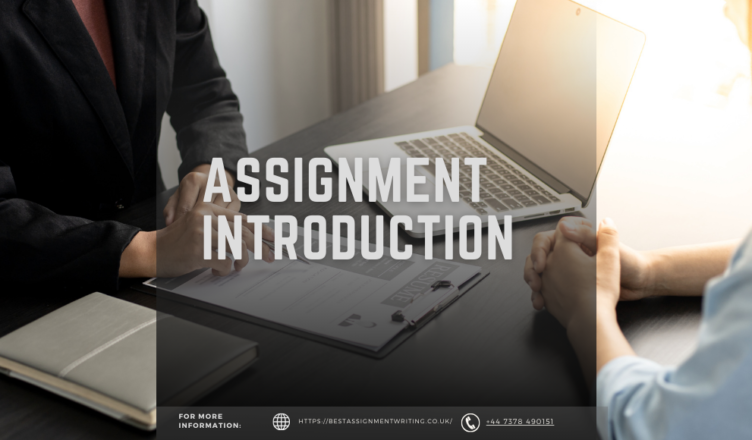Introduction:
Imagine your assignment as a journey. The introduction is the gateway that invites your reader to step into this journey. Just as a well-crafted entrance sets the tone for a great adventure, an expertly composed assignment introduction lays the foundation for a compelling academic exploration. In this article, we will unveil the art of crafting an introduction that captivates, informs, and guides the reader, allowing you to compose assignments like an expert writer.
● Establish Clarity and Purpose
The opening sentences of your introduction should be clear and concise. They should set the stage by introducing the topic, defining key terms, and providing context. An introduction must be clear to readers and deter them from continuing the journey. Remember, the introduction aims to inform the reader about what to expect in your assignment.
● Engage Your Reader
A practical introduction should not just inform but also engage the reader. Use a hook or an intriguing statement to pique the reader’s curiosity. This could be a relevant quote, a surprising fact, or a thought-provoking question. Engaging your reader from the beginning encourages them to invest their time in your assignment.
● State Your Thesis
Your thesis statement is the heart of your assignment. It presents the central argument or purpose of your work. In the introduction, clearly state your thesis to guide the reader’s understanding of your assignment’s focus. A well-crafted idea provides a roadmap for your readers, helping them anticipate the key points you will address.
● Provide a Brief Overview
After stating your thesis, offer a brief overview of the main points or arguments covered in the assignment. This serves as a preview, giving the reader an idea of the structure and direction of your work. It helps them stay oriented as they progress through your assignment.
● Keep It Concise
While the introduction should be informative and engaging, it should also be concise. Avoid overloading it with excessive details or background information. Stick to the essentials that are directly relevant to your assignment’s focus. A lengthy introduction can overwhelm the reader and obscure your main points.
● Use a Clear and Cohesive Structure
Maintain a logical flow in your introduction. Ensure that each sentence leads smoothly to the next, creating a cohesive structure. A well-structured introduction is accessible for the reader to follow, enhancing their comprehension of your assignment opening.
● Revise and Refine
Writing a practical introduction often requires multiple revisions. After completing your assignment, revisit the opening to ensure it accurately reflects the content and arguments you’ve presented. Make adjustments as needed to maintain alignment.
● Avoid Plagiarism
While drawing inspiration from external sources is acceptable, be cautious not to plagiarize in your introduction. Properly cite any quotes or ideas you borrow from other works. Plagiarism can severely impact your academic credibility.
Begin with a Hook
The first sentence of your introduction should be a hook that captivates your reader’s attention. It could be a thought-provoking question, a surprising fact, a relevant quote, or a compelling anecdote. The goal is to make the reader want to continue reading to learn more.
Provide Context
After hooking your reader, providing Context for your assignment is essential. Briefly explain the topic, its significance, and why it matters. This helps your reader understand the relevance of your work and why it’s worth their time.
State Your Thesis
A clear and concise thesis statement is the backbone of your introduction. It should clearly state the central argument or purpose of your assignment. Your thesis sets the direction for the entire paper and informs the reader about what to expect.
Outline Your Approach
Briefly outline the approach or methodology you will use in your assignment. This gives the reader a sense of how you will tackle the topic and what methods or sources you will use to support your argument.
Mention Key Points
If your assignment has specific sections or critical points, consider mentioning them briefly in the introduction. This provides a roadmap for your readers and prepares them for what’s coming next.
Keep It Concise
While it’s essential to include all necessary elements, keeping your introduction concise is equally crucial. Aim for clarity and brevity. Avoid unnecessary jargon or overly complex language that might confuse your reader.
Revise and Edit
After drafting your introduction, take the time to revise and edit it. Ensure that each sentence contributes to the overall flow and purpose of the opening. Check for grammar and punctuation errors to maintain professionalism.
Conclusion:
Composing an assignment introduction like an expert writer is a skill that can be honed through practice and attention to detail. Remember that the opening is your opportunity to create a solid first impression, engage your readers, and guide them through your assignment’s journey. With clarity, engagement, and a well-defined thesis, you can craft introductions that set the stage and showcase your expertise as a writer. As you continue your academic endeavors, use these principles to ensure your introductions are informative and captivating, leading your readers on a fulfilling intellectual adventure.

